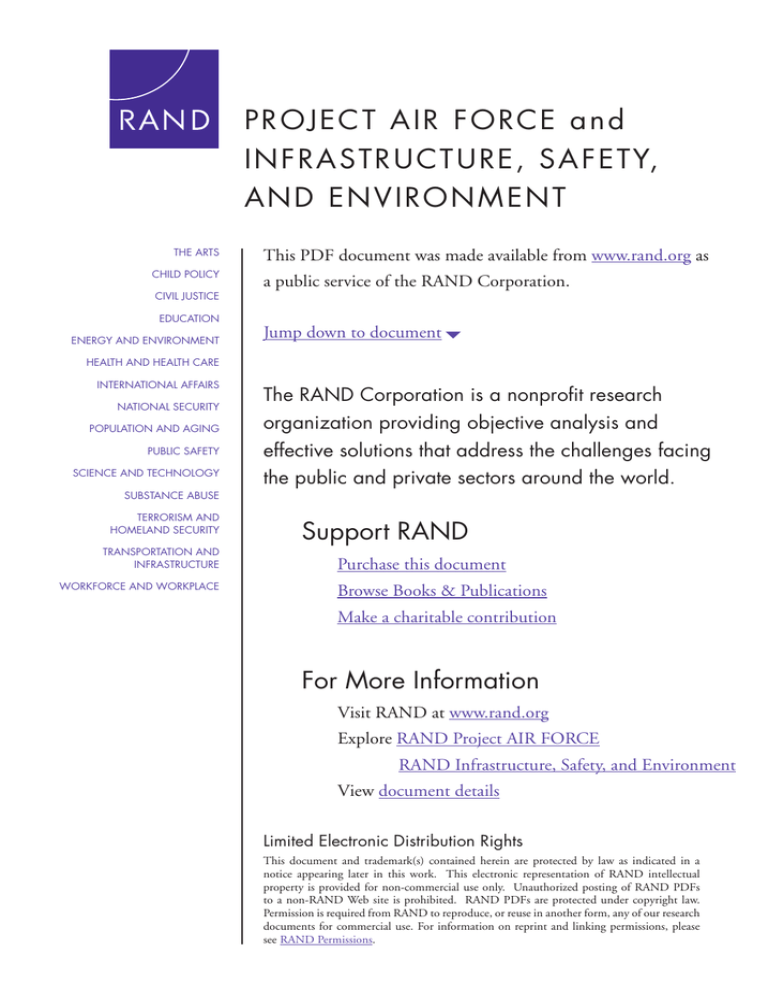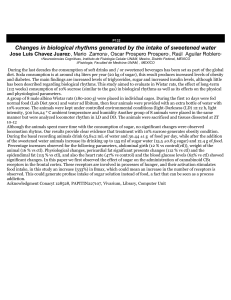
PROJECT AIR FORCE and
INFRASTRUCTURE, SAFETY,
AND ENVIRONMENT
THE ARTS
CHILD POLICY
CIVIL JUSTICE
EDUCATION
ENERGY AND ENVIRONMENT
This PDF document was made available from www.rand.org as
a public service of the RAND Corporation.
Jump down to document6
HEALTH AND HEALTH CARE
INTERNATIONAL AFFAIRS
NATIONAL SECURITY
POPULATION AND AGING
PUBLIC SAFETY
SCIENCE AND TECHNOLOGY
SUBSTANCE ABUSE
TERRORISM AND
HOMELAND SECURITY
TRANSPORTATION AND
INFRASTRUCTURE
WORKFORCE AND WORKPLACE
The RAND Corporation is a nonprofit research
organization providing objective analysis and
effective solutions that address the challenges facing
the public and private sectors around the world.
Support RAND
Purchase this document
Browse Books & Publications
Make a charitable contribution
For More Information
Visit RAND at www.rand.org
Explore RAND Project AIR FORCE
RAND Infrastructure, Safety, and Environment
View document details
Limited Electronic Distribution Rights
This document and trademark(s) contained herein are protected by law as indicated in a
notice appearing later in this work. This electronic representation of RAND intellectual
property is provided for non-commercial use only. Unauthorized posting of RAND PDFs
to a non-RAND Web site is prohibited. RAND PDFs are protected under copyright law.
Permission is required from RAND to reproduce, or reuse in another form, any of our research
documents for commercial use. For information on reprint and linking permissions, please
see RAND Permissions.
This product is part of the RAND Corporation monograph series. RAND
monographs present major research findings that address the challenges facing
the public and private sectors. All RAND monographs undergo rigorous peer
review to ensure high standards for research quality and objectivity.
Producing Liquid Fuels
from Coal
Prospects and Policy Issues
James T. Bartis, Frank Camm, David S. Ortiz
Prepared for the United States Air Force and the
National Energy Technology Laboratory of the
United States Department of Energy
Approved for public release; distribution unlimited
PROJEC T A IR FO RCE an d
INF RAS TR UCTURE , SA FE TY, A ND E N VI R O N M E N T
The research described in this report was sponsored by the United States
Air Force under Contract FA7014-06-C-0001. Further information
may be obtained from the Strategic Planning Division, Directorate
of Plans, Hq USAF. It was also supported by the National Energy
Technology Laboratory, United States Department of Energy, and
was conducted under the auspices of the Environment, Energy, and
Economic Development Program within RAND Infrastructure, Safety,
and Environment.
Library of Congress Cataloging-in-Publication Data is available for this publication.
ISBN: 978-0-8330-4511-9
The RAND Corporation is a nonprofit research organization providing
objective analysis and effective solutions that address the challenges
facing the public and private sectors around the world. R AND’s
publications do not necessarily reflect the opinions of its research clients
and sponsors.
R® is a registered trademark.
Cover photo courtesy of Peabody Energy Corporation.
© Copyright 2008 RAND Corporation
All rights reserved. No part of this book may be reproduced in any
form by any electronic or mechanical means (including photocopying,
recording, or information storage and retrieval) without permission in
writing from RAND.
Published 2008 by the RAND Corporation
1776 Main Street, P.O. Box 2138, Santa Monica, CA 90407-2138
1200 South Hayes Street, Arlington, VA 22202-5050
4570 Fifth Avenue, Suite 600, Pittsburgh, PA 15213-2665
RAND URL: http://www.rand.org
To order RAND documents or to obtain additional information, contact
Distribution Services: Telephone: (310) 451-7002;
Fax: (310) 451-6915; Email: order@rand.org
Summary
During 2007 and 2008, world petroleum prices reached record highs, even after adjusting for inflation. Concerns about current and potentially higher future petroleum costs
for imported oil have renewed interest in finding ways to use unconventional fossilbased energy resources to displace petroleum-derived gasoline and diesel fuels. If successful, this course of action would lower prices and reduce transfers of wealth from
U.S. oil consumers to foreign oil producers, resulting in economic gains and potential
national-security benefits.
Oil shale, tar sands, biomass, and coal can all be used to produce liquid fuels. Of
these, coal appears to show the greatest promise, considering both production potential
and commercial readiness. It is the world’s most abundant fossil fuel. Global, proven
recoverable reserves are estimated at one trillion tons (World Energy Council, 2004),
which represent nearly three times the energy of the proven reserves of petroleum.
The technology for converting coal to liquid fuels already exists. Commercial
coal-to-liquids (CTL) production has been under way in South Africa since the 1950s.
Moreover, CTL production appears to be economically feasible at crude oil prices
well below the prices seen in 2007 and 2008. However, without effective measures to
manage greenhouse-gas emissions, the production and use of coal-derived liquids to
displace petroleum-derived transportation fuels could roughly double the rate at which
carbon dioxide is released into the atmosphere. In the absence of an effective national
program to limit greenhouse-gas emissions, it is unclear whether the federal government would support the development of a CTL industry capable of producing millions
of barrels per day (bpd) of liquid fuels.
Research Goals and Methodology
This study analyzed the costs, benefits, and risks of developing a U.S. CTL industry that is capable of producing liquid fuels on a strategically significant scale. Our
research approach consisted of the following basic steps:
xv
xvi
Producing Liquid Fuels from Coal: Prospects and Policy Issues
t To understand commercial development prospects, we examined what is known
and not known regarding the economic and technical viability and the environmental performance of commercial-scale CTL production plants.
t To quantify benefits and understand how the large-scale introduction of unconventional fuel sources might affect both the world price of oil and the well-being
of oil consumers and producers, we developed a model of the global oil market
designed to allow us to compare policy alternatives in the face of inherent uncertainties about how various aspects of the market might behave in the future.
t To investigate how integrated packages of public policy instruments could encourage investment in unconventional-fuel production plants, we reviewed fundamental aspects of contract design and developed a financial model to determine
how those incentive packages might affect (1) the rate of return to investors and
(2) the net present value of cash flows between such plants and the government.
Finally, our study consistently took into account two overarching policy goals:
reducing dependence on imported oil and decreasing greenhouse-gas emissions.
Principal Findings
U.S. Coal Resources Can Support a Domestic Coal-to-Liquids Industry Far into the
Future
The United States leads the world with recoverable coal reserves estimated at approximately 270 billion tons. These reserves are broadly distributed, with at least 16 states
having sufficient reserves to support commercial CTL production plants (see pp. 9–12).
In 2006, the United States mined a record 1.16 billion tons of coal, nearly all of which
was used to produce electric power. Dedicating only 15 percent of recoverable coal
reserves to CTL production would yield roughly 100 billion barrels of liquid transportation fuels, enough to sustain three million bpd of CTL production for more than 90
years (see pp. 12–13).
Technology for Producing Coal-to-Liquids Fuels Has Advanced in Recent Years
In the United States, interest in CTL fuels has concentrated on two production
approaches that begin with coal gasification: the Fischer-Tropsch (FT) and methanolto-gasoline (MTG) liquefaction methods. The FT method was invented in Germany
during the 1920s and is in commercial practice in South Africa. The Mobil Research
and Development Corporation invented the MTG approach in the early 1970s. Both
approaches involve preparing and feeding coal to a pressurized gasifier to produce synthesis gas—the important constituents of which are hydrogen and carbon monoxide.
After deep cleaning, processing, and removal of carbon dioxide, the synthesis gas is
sent to a catalytic reactor, where it is converted to liquid hydrocarbons. The principal
Summary
xvii
products of an FT CTL plant are exceptionally high-quality diesel and jet fuels that
can be sent directly to local fuel distributors (see pp. 20–22). In an MTG CTL plant,
the synthesis gas is first converted to methanol. The methanol is then converted to a
mix of hydrocarbons that are very similar to those found in raw gasoline. Between 90
and 100 percent of the final liquid yield of an MTG CTL plant is a zero-sulfur automotive gasoline that can be distributed directly from the plant. (See pp. 25–26.)
A favorable attribute of both approaches is that the synthesis gas can be produced
from a variety of feeds, including natural gas, biomass, and coal. Although no FT
CTL plants have been built in more than 20 years, the FT approach has advanced
through the recent and ongoing construction of large commercial plants designed to
produce liquids from natural gas that cannot be pipelined to nearby markets (see p. 19).
Although no commercial MTG CTL plant has ever been built, we judge the process
as ready for initial commercial operations, based on ten years of large-scale operating
experience, starting in 1985, when the process was commercially applied to produce
gasoline from natural-gas deposits in New Zealand (see pp. 24–25).
Technology for Controlling Carbon Dioxide Emissions Is Advancing
If the entire fuel cycle is taken into account—i.e., oil well or coal mine through production to end use—we estimate that greenhouse-gas emissions from a CTL plant
would be about twice those associated with fuels produced from conventional crude
oils. Slightly higher values would result from less efficient CTL plants or by comparing
with light crude oils. And slightly lower values would result from more energy-efficient
CTL plant designs or by comparing with the heavier crude oils that are taking an
increasing role in worldwide oil production. Technological advances aimed at significantly improving the energy efficiency and costs of CTL production might be able to
reduce plant-site greenhouse-gas emissions by one-fifth—not enough to match those
of conventional petroleum (see pp. 31–32). To avoid conflict with growing national
and international priorities to reduce global greenhouse-gas emissions, the large-scale
development of a CTL industry requires management of plant-site carbon dioxide
emissions.
Capturing the carbon dioxide that would be otherwise emitted from a CTL plant
is straightforward and relatively inexpensive. CTL plants already remove carbon dioxide from the synthesis gas, so capture simply involves dehydrating and compressing
the carbon dioxide so that it is ready for pipeline transport. If 90 percent of plant-site
emissions were to be fully captured and then stored, the production and use of fuels
produced in early CTL plants should not cause any significant increase or decrease in
greenhouse-gas emissions as compared to fuels derived from conventional light crude
oils. For nearly full capture of plant-site carbon dioxide emissions, we estimate that
product costs would increase by less than $5.00 per barrel. (See pp. 32–33.)
There are two principal methods for disposing of the captured carbon dioxide.
The first is to use the captured carbon dioxide to enhance oil recovery in partially
xviii
Producing Liquid Fuels from Coal: Prospects and Policy Issues
depleted oil reservoirs using a well-known method called carbon dioxide flooding. The
advantage of this method is that at least two barrels of additional conventional petroleum will be produced for each barrel of CTL fuel. Moreover, CTL plant operators
might be able to sell their captured carbon dioxide at a profit above their costs of capture and transport. This enhanced oil recovery method is limited to the first 0.5 million bpd to one million bpd of CTL production capacity built within a few hundred
miles of appropriate oil reservoirs. A pioneer field test and demonstration of carbon
dioxide sequestration through enhanced oil recovery has been under way since 2000 at
the Weyburn oil field in Saskatchewan. (See pp. 34–36.)
The second method is to sequester carbon dioxide in various types of geologic
formations. The latter approach is broadly viewed as the critical technology that will
allow continued coal use for power generation while reducing greenhouse-gas emissions. Two major demonstrations of carbon dioxide sequestration in geological formations are under way outside the United States. Results to date have been promising
(see p. 36). However, the development of a commercial sequestration capability within
the United States requires addressing important knowledge gaps associated with site
selection and preparation, predicting long-term retention, and monitoring and modeling the fate of the sequestered carbon dioxide. There are also important legal and
public acceptance issues that must be addressed. Toward this end, U.S. Department of
Energy plans to conduct at least eight moderate- to large-scale demonstrations over the
next five years. (See pp. 74–75.)
A Combination of Coal and Biomass to Produce Liquid Fuels May Be a Preferred
Solution
Biomass can be converted to a synthesis gas that FT reactors can use to produce fuels
identical to those derived from coal or natural gas. The biomass-to-liquids (BTL)
approach results in low total-fuel-cycle release of greenhouse gases because the emissions at the plant are balanced by the carbon dioxide absorbed from the atmosphere
during the growth cycles of the biomass crops.
A promising direction for alternative-fuel production would be an integrated
FT or MTG plant designed to accept both biomass and coal. A coal- and biomassto-liquids (CBTL) approach can ameliorate problems created by the use of biomass
alone—i.e., the logistics of biomass delivery that limit production levels and the annual
climate variations that can cause major fluctuations in the quantity of biomass available to a BTL-only plant. A CBTL plant can be substantially larger than a BTL plant,
and its large-scale economies would enable it to operate at a significantly lower cost.
The marginal benefits of adding a coal feedstock to a biomass feedstock may more than
offset the marginal costs associated with sequestering the increased carbon dioxide
emissions that result. (See pp. 37–38.)
Given information that is currently available and considering the entire fuel cycle,
we conclude that CBTL fuels can be produced and used at greenhouse-gas emission
Summary
xix
levels that are well below those associated with the production and use of conventional
petroleum fuels. For example, with 90-percent sequestration of plant-site emissions,
we estimate that a 55/45 coal/dry biomass mix (based on energy input) will result in
CBTL fuel production with zero net greenhouse-gas emissions considering the full
fuel cycle from coal mining and biomass cultivation to end use. Likewise, a 75/25 coal/
dry biomass mix would yield roughly a 55- to 65-percent reduction in greenhouse-gas
emissions, as compared to conventional petroleum fuels. (See pp. 39–40.)
Developing a Coal-to-Liquids Industry in the United States Will Be Expensive, but
Significant Production Is Possible by 2030
CTL plants are capital intensive. For moderate to large CTL plants, we estimate capital investment costs of $100,000 to $125,000 (in January 2007 dollars) per barrel of
product. Considering operating and coal costs, we estimate that, for CTL fuels to be
competitive, the selling price for crude oil (using a West Texas Intermediate benchmark) must be between $55 and $65 per barrel. These prices include the costs of capturing about 90 percent of carbon dioxide emissions but do not assume any income or
outlays associated with sequestering that carbon dioxide. Our cost estimates are highly
uncertain, since they are based on low-definition engineering designs. Also, our estimates apply only to the first generation of CTL plants built in the United States. We
expect the cost of building and operating new plants to drop significantly once early
commercial plants begin production and experience-based learning is under way. (See
pp. 42–45.)
Considering the importance of experience-based learning, the need to avoid costfactor escalation, and the time required to bring carbon capture and sequestration to
full commercial viability, we estimate that, by 2020, the production level of CTL fuels
can be no more than 500,000 bpd. Post-2020 capacity buildup could be rapid, with
U.S.-based CTL production potentially in the range of three million bpd by 2030. (See
pp. 46–48)
Coal-to-Liquids Development Offers Strategic National Benefits
The United States now consumes about 20 million barrels of liquid fuels per day. This
level of use is projected to rise slightly over the next 25 years. If a domestic CTL industry is developed and operates on a profitable basis, the United States would benefit
from the economic profits generated by that industry. CTL production would benefit oil consumers by reducing the world price of oil, and this reduction in world oil
prices would yield national security benefits. Having a domestic CTL industry in place
would also increase the resiliency of the petroleum supply chain in the United States
and provide enhanced employment opportunities, especially in states holding large
reserves of coal. To examine these benefits, we assumed a hypothetical domestic CTL
production rate of three million bpd by 2030.
xx
Producing Liquid Fuels from Coal: Prospects and Policy Issues
Economic Profits. If a large CTL industry develops by 2030, we anticipate that
post-production learning will result in significantly lower CTL production costs. At
world crude oil prices of between $60 and $100 per barrel (2007 dollars), direct economic profits of between $20 billion and $70 billion per year are likely. Through various taxes, a portion of these profits, between $7 billion and $25 billion per year, would
go to federal, state, and local governments and thereby broadly benefit the public. (See
p. 60.)
Reduced World Oil Prices. Lower world oil prices will likely be the result of any
increase in liquid-fuel production, either domestically or abroad, from unconventional
resources. Based on examining a broad range of potential responses by the Organization of the Petroleum Exporting Countries (OPEC), we anticipate that world oil prices
will drop by between 0.6 and 1.6 percent for each million barrels of unconventionalfuel production that would not otherwise be on the market. Further, this price decrease
should be close to linear for unconventional-fuel additions of up to ten million bpd.
Unconventional-fuel additions in this range are possible, but only by considering
potential 2030 production levels from domestic oil shale and biofuel resources as well
as both domestic and international production of coal-derived liquid fuels. Looking
only at coal-derived liquids, it is possible that total world production could reach about
six million bpd by 2030. (See p. 62.)
By reducing oil prices, consumer and business users of oil in the United States
(and elsewhere) would benefit. From a national perspective, reduced profits to domestic petroleum producers would offset a portion of these benefits. Considering both
oil users and producers, we estimate a net national benefit at between $2 billion and
$8 billion per year for each million barrels per day of unconventional-fuel production
(see pp. 63–65). Or equivalently, by lowering world oil prices, each barrel of CTL benefits the overall economy by between $6 and $24. The estimate of these benefits reflects
our judgment that long-term oil prices will range between $60 and $100 per barrel
with a range of market responses to the added supplies of liquid fuels. These benefits
accrue to the nation as a whole, as opposed to the individual firms investing in CTL
production. These analytic results support our finding that, to counter efforts of certain foreign oil suppliers to control prices by restraining production, the United States
should be willing to spend $6 to $24 per barrel more than market prices for substitutes
that reduce oil demand. (See pp. 65–66.)
National Security Benefits. The national security benefits of having a domestic
CTL industry in place flow primarily from the anticipated reduction in world oil prices
and thereby a reduction in revenues to oil-exporting countries. To the extent that this
reduction in prices and revenues helps to limit behavior counter to U.S. national interests, there would be a benefit beyond the economic gain in reduced oil prices just
noted. However, a three million bpd domestic industry would yield between a 3- and
8-percent reduction in the revenues of oil exporters. This small change in revenue
would unlikely change the political dynamics in oil-producing nations unfriendly to
Summary
xxi
the United States. With regard to enhancing national security, the principal contribution of CTL production would be its role in a portfolio of measures to increase liquidfuel supplies and reduce oil demand. For example, global unconventional-fuel production of ten million bpd by 2030 could reduce OPEC annual revenues by up to a few
hundred billion dollars. (See pp. 66–67.)
Environmental Impacts of a Large-Scale Coal-to-Liquids Industry Will Need to Be
Addressed
Under current federal and state environmental, reclamation, and safety laws and regulations, the land, air, water, and ecological impacts of coal mining are mitigated to
varying degrees. However, residual impacts of mining activities can still adversely
change the landscape, the local ecology, and water quality. CTL development at a scale
of three million bpd by 2030 would require about 550 million tons of coal production
annually. Depending on whether and how greenhouse-gas emissions are controlled
during this period, the net change in coal production between now and 2030 resulting
from a gradual buildup of demand from a CTL industry could range from minimal up
to an increase of about 50 percent above current levels. If large-scale development of a
CTL industry is accompanied by a significant net increase in coal production or a significant change in extraction technologies, a review of the legislation and regulations
governing mine safety, environmental protection, and reclamation may be appropriate.
Such a review would assess the potential environmental and safety impacts of increased
mining activity and evaluate options for reducing such impacts. More immediately,
there is a clear need for research directed at mitigating the known and anticipated
environmental impacts and reducing the work hazards associated with coal mining.
(See pp. 78–79.)
Because of advances in environmental control technologies, CTL plant operations should not pose significant threats to air and water quality. There will be some
locations where CTL development will be limited or prohibited, but, given the geographic diversity of the domestic coal resource base, large-scale development is unlikely
to be impaired by a lack of suitable plant sites. (See pp. 76–78.)
It is difficult to predict how future, more technically mature CTL plants would
manage water supply and consumption, especially in arid regions of Montana and
Wyoming that hold enormous coal resources. Although design options are available to
reduce water use in CTL plants, water consumption may be a limiting factor in locating multiple CTL plants in arid areas. (See pp. 79–81.)
Uncertainties Are Impeding Private Investment
Although numerous private firms have expressed considerable interest in CTL development in the United States, actual investment levels appear to be very limited. Discussions with proponents of CTL development indicate that three major uncertainties are
impeding private investments:
xxii
Producing Liquid Fuels from Coal: Prospects and Policy Issues
t uncertainty about CTL production costs
t uncertainty regarding how and whether to control greenhouse-gas emissions
t uncertainty regarding the future course of world crude oil prices.
Of these three factors, the greatest impediment appears to be the uncertainty
regarding future world oil prices. If investors would be confident that average longterm crude prices would remain consistently above $100 per barrel, no government
policy would be required to support the emergence of a successful commercial CTL
industry. But with the possibility that oil prices could fall significantly in the near to
medium term, the financial risk surrounding initial CTL investments is appreciable.
Given the extremely large capital investment required for even a moderate-size CTL
plant, very few firms have the financial resources to take on this risk. (See p. 82.)
To Spur Early Coal-to-Liquids Production Experience, Government Incentives
Should Target Prevailing Uncertainties
The firms most capable of overseeing the design, construction, and operation of CTL
plants are the major petrochemical companies, which have the technical capabilities
and the financial and management experience necessary for investing in multibilliondollar megaprojects. They are also best suited to exploit the learning that would accompany early production experience. Yet none has announced interest in building first-ofa-kind CTL plants in the United States. (See p. 81.)
How can the federal government encourage the early participation of these and
other capable companies in the CTL enterprise? The answer lies in the creation of
incentive packages that cost-effectively transfer a portion of investment risks to the
federal government.
We found that a balanced package of a price floor, an investment incentive, and
an income-sharing agreement is well suited to do this. The investment incentive, such
as a tax credit, is a cost-effective way to raise the private, after-tax internal rate of return
in any future. A price floor provides protection in futures in which oil prices are especially low. And an income-sharing agreement compensates the government for its costs
and risk assumption by providing payments to the government in futures in which oil
prices turn out to be high (see pp. 92–96). Because the most desirable form of a balanced package depends on expectations about project costs, the government should
wait to finalize its design until it has the best information on project costs that is available without actually initiating the project. Specifically, an incentive agreement should
not be finalized until both government and investors have the benefit of improved
project-cost and performance information that would be provided at the completion of
a front-end engineering design. (See pp. 96–97.)
Loan guarantees can strongly encourage private investment. However, they
encourage investors to pursue early CTL production experience only by shifting real
default risk from private lenders to the government. By their very nature, the more
Summary
xxiii
powerful their effect on private participation, the higher the expected cost of these loan
guarantees to the government. In addition, loan guarantees encourage private investors to seek higher debt shares that increase the risk of default and thus increase the
government’s expected cost for providing the guarantee. The government should take
great care in employing loan guarantees to promote early CTL production experience.
It should fully recognize both the costs that such guarantees could impose on taxpayers
and the extent to which government oversight of guaranteed loans can be effective in
limiting those costs. (See pp. 98–100.)
Overall Prospects
The prospects for developing an economically viable CTL industry in the United States
are promising, although important uncertainties exist. Both FT and MTG CTL technologies are ready for initial commercial applications in the United States; production
costs appear competitive at world oil prices well below current levels; and proven coal
reserves in the United States are adequate to support a large CTL industry operating
over the next 100 years.
Opportunities to control greenhouse-gas emissions from CTL plants are currently limited to enhanced oil recovery. But the prospects for successful development
of large-scale geologic sequestration are promising, as is the development of technology
that would allow the combined use of coal and biomass in production plants based
on either the FT or MTG approaches. Within a few years, CTL plants could begin
to alleviate growing global dependence on price-controlled conventional petroleum
at greenhouse-gas emission levels comparable to those associated with conventionalpetroleum products. Within a few more years, we anticipate that approaches would be
available that allow the combined use of coal and biomass to produce liquid fuels so
that total-fuel-cycle greenhouse-gas emission levels are significantly below those associated with conventional petroleum. (See pp. 46–48.) Most importantly, the low cost
of capturing carbon dioxide at CTL plants implies that any measure that will induce
reductions in greenhouse-gas emissions from coal-fired power plants will also be more
than adequate to promote deep removal at CTL or CBTL plants (see p. 74).
Key Recommendations
With regard to the development of coal-derived liquids or other unconventional-fuel
sources, the government could place itself anywhere along a continuum of policy positions. At one extreme is the hands-off position, which favors the free operation of the
market and private decisionmaking unfettered by government interference. Support
would be available for long-term research and development directed at significantly
improving the economic and environmental performance of CTL production but not
for near-term technology development or demonstration activities. (See pp. 106–107.)
xxiv
Producing Liquid Fuels from Coal: Prospects and Policy Issues
At the other extreme, the government could choose specific alternatives to conventional oil production today and initiate large-scale federal support of these alternatives to ensure successful development of a new industry that can displace conventional
oil production in the world market over the long term. (See pp. 107–109.)
Our research supports a policy strategy that falls between these extremes. This
insurance-policy approach recognizes prevailing uncertainties and emphasizes future
capabilities. The five elements of the insurance strategy are as follows:
t Cost-share a few site-specific front-end engineering design studies of CTL and
dual-feedstock production plants to establish costs, risks, potential economic performance, and environmental impacts. (See p. 109.)
t Use federal incentives to ensure early commercial production experience with a
limited number of first-of-a-kind CTL or dual-feedstock plants to establish performance and provide a foundation for post-production learning. (See p. 110.)
t Conduct multiple large-scale, long-term demonstrations of the sequestration of
carbon dioxide generated at electricity-generation or CTL production plants (or
both) at a scale and duration beyond that currently planned for in the U.S. Department of Energy’s Regional Carbon Sequestration Partnerships. (See p. 111.)
t Undertake the research, development, and testing required to establish the technical viability of using a combination of biomass and coal for liquid production.
(See p. 112.)
t Broaden and expand the federal portfolio directed at long-term, high-payoff
research relevant to transportation fuel production. (See p. 112.)
The principal value of federal efforts to implement an insurance strategy is to
accelerate CTL commercial development above what it would otherwise be. A five-year
acceleration of development of a strategically significant CTL industry in the United
States could result in national economic benefits with a present value of about $100 billion. (See p. 117.)
Air Force Options for Coal-to-Liquids Industrial Development
Should the Air Force choose to play an active role in promoting the development of a
domestic CTL industry, it should do so recognizing that the primary potential benefits of success would accrue more to the nation as a whole than to the Air Force as an
institution. (See p. 113.)
The U.S. Air Force’s 2016 goal of being prepared to acquire alternative fuel blends
to meet 50 percent of its domestic aviation fuel requirements is consistent with an overall federal insurance-policy strategy. The amount of FT CTL capacity required to meet
the potential fuel purchases associated with the U.S. Air Force goal (50,000–80,000
Summary
xxv
bpd) falls within the overall production requirements of an insurance strategy, namely,
obtaining early production experience from a limited number of CTL plants. (See
p. 106.)
The U.S. Air Force might consider using fuel purchase contracts to promote early
CTL production experience. To be more cost-effective, such contracts should be part
of a broader federal package of investment incentives, such as investment tax credits, accelerated depreciation, and loan guarantees. These additional instruments could
allow lower price floors and lessen the probability of out-year government purchases at
above-market prices. (See pp. 92–93.)
Another option that the U.S. Air Force and the U.S. Department of Defense
(DoD) might consider is to use DoD’s contracting authority to establish a guaranteed
or fixed price over a significant portion of the operating life of a CTL plant. Such
agreements are rarely observed in contracts between private parties. Our findings indicate that a long-term price guarantee should be avoided because it is among the least
cost-effective approaches available to the federal government. (See p. 114.)
Currently, DoD contracts are limited by law (10 USC 2306b) to a duration of
no more than five years, with options for an additional five years, and a total amount
of less than $500 million, unless specifically authorized otherwise by Congress. As
such, DoD’s ability to provide incentives for private investments in early CTL plants
is severely limited. New legislative authority is needed if DoD and the U.S. Air Force
wish to overcome the limitations imposed on contract duration and size. (See p. 114.)






